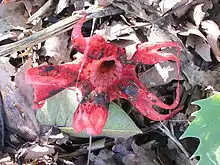Aseroe
Aseroe is a small genus of basidiomycete fungi of the family Phallaceae, though sometimes placed in the separate family Clathraceae. The genus name is derived from the Ancient Greek words Asē/αση 'disgust' and roē/ροη 'juice'.[1] The genus was described with the collection and description of the type species Aseroe rubra in 1800 by French botanist Jacques Labillardière. As with other stinkhorn-like fungi, mature fruiting bodies are covered with olive-brown slime, containing spores, which attracts flies. These fungi are common in mulch and are saprobic.
| Aseroe | |
|---|---|
 | |
| Aseroe rubra | |
| Scientific classification | |
| Domain: | Eukaryota |
| Kingdom: | Fungi |
| Division: | Basidiomycota |
| Class: | Agaricomycetes |
| Order: | Phallales |
| Family: | Phallaceae |
| Genus: | Aseroe Labill. (1800) |
| Type species | |
| Aseroe rubra Labill. (1800) | |
| Species | |
Species
As of August 2022, Species Fungorum accepted 3 species of Aseroe.[2]
- Aseroe coccinea
- Aseroe genovefae
- Aseroe rubra
References
- Liddell, Henry George and Robert Scott (1980). A Greek-English Lexicon (Abridged ed.). United Kingdom: Oxford University Press. ISBN 0-19-910207-4.
- "Species Fungorum - Aseroe". www.speciesfungorum.org. Retrieved 2022-07-10.
External links
- "Aseroe Labill". Atlas of Living Australia. Archived from the original on 2018-03-27. Retrieved 2018-03-27.
This article is issued from Wikipedia. The text is licensed under Creative Commons - Attribution - Sharealike. Additional terms may apply for the media files.